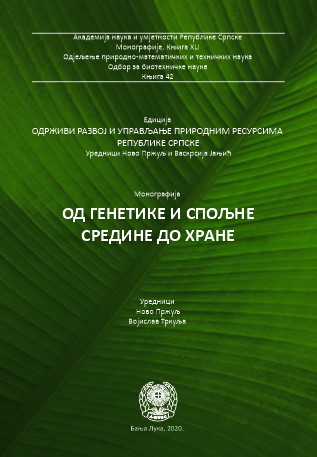Significance of wild relatives genetic variability in cultivated plants breeding
DOI:
https://doi.org/10.7251/EORU2001091AKeywords:
Crop wild relatives, genetic resources, climate changes, improved varietiesAbstract
The challenge of ensuring global security in food production and availability worldwide is very large and demanding. The expected increase in the population on Earth, changes in needs and eating habits, will increase the demand in food systems in the coming decades, much more than the expected increase in the yield of cultivated plants. Constraints in land, water and other natural resources, competition between arable and non-arable land, soil degradation, climate change and the need to minimize adverse impacts on ecosystems and biodiversity, further limit the existing potential for food production. Although increased food availability can be achieved in part by changing diets and increasing productivity, the sustainability of existing agricultural systems is essential. The basis for increasing sustainability is the use of new genetic diversity in plant breeding to create varieties that contain traits such as tolerance to drought and high temperatures, increased resistance to pests and diseases, and improved quality of plant parts used in human nutrition. As sources of new variability, crop wild relatives have been used for decades in plant breeding, contributing to a large number of useful agronomic and nutritional traits. Their use is expected to increase as a result of the steady increase in information on wild species and their diversity, and advances in conventional and molecular breeding. Expectations are based on the assumption that crop wild relatives will be easily available for research and breeding, which requires their organized collection, conservation, and access to germplasm in gene banks and protected areas where they grow. Collections in gene banks are often incomplete and do not include the existing variability of wild relatives. The collection of crop wild relatives should focus in particular on areas with extreme climatic conditions, where it is possible to find gene / traits that are not found in natural (normal) ecological conditions. The processes of introducing genetic diversity from wild relatives into cultivated plants are long-lasting and begin in nature, where botanists, taxonomists and genetic resource experts collect wild relatives. Then the curators in the gene banks perform conservation and characterization; geneticists, agronomists, phytopathologists, entomologists andphysiologists further evaluation, after which pre-breeders and breeders incorporate desirable alleles into new varieties. Large collections of germplasms in gene banks in which wild relatives are underrepresented, as well as evaluation of samples in different external environments, which were not targeted according to potential use in breeding, are reasons for low usability of crop wild relatives. In general, there is a lack of information on economic important traits which often have a high interaction by environment. All of this is a problem for breeders to successfully select the appropriate genetic divergence and sources of variability for their breeding programs. Although gene banks have significantly facilitated the use of wild relatives, their disadvantage is that they store only a fraction of the total genetic variability that exists in wild relatives. In ex situ conservation, plants are not exposed to selection processes to which natural populations are exposed, thus preserving the evolutionary process. The advantage of in situ conservation is that it allows the creation of new variability that arises as a result of adaptation of populations to environment and biotic factors, which is especially important in the context of current climate change. This means that in addition to ex situ collections, it is necessary to have in situ conservation of wild relatives, in order to maintain much wider genetic diversity and ensure that habitats where wild relatives grow are protected, so that these plants continue to develop in the wild. Accurately defined relations between cultivated plants and wild relatives are of particular importance for exploiting the benefits of wild germplasm. Effective use of wild relatives requires their accurate identification, clsification and characterization. Identification only on the basis of morphological features often leads to errors in systematizations, especially in the case of morphologically similar and related species. The largest number of accessions in gene banks was identified only up to the genus level. Therefore, precise identification is necessary for the determination of genes and defining the manner of their transfer in the breeding. Providing breeders with the genetic diversity of wild relatives through the prebreeding process is very useful for faster and more efficient introduction of desirable traits from wild relatives into modern varieties. The pre-breeding process does not produce varieties that can be grown directly, but a set of genotypes with desirable alleles that will, later in crosses, be incorporated into new varieties. In today's breeding programs, hybridization is the basic way to introduce new genes into cultivated plants. A large number of cultivated plants have wild relatives with which they are compatible and it is possible to use theirgenes by simple hybridization to improve some traits of cultivated plants. Finding new methods for crossing cultivated plants and their wild relatives is an ongoing task in order to efficiently use the genetic variability of wild relatives. After the crossings, it is necessary to form a large population of offspring to study the effect of the introduced gene, its mapping in the genome and its exploitation using marker assisted selection. The application of modern molecular and genomic techniques in the identification of genes of interest in wild relatives of cultivated plants can accelerate the process of creating superior cultivars for the needs of increased agricultural production. Preliminary assessments have shown some shortcomings in the conservation of wild relatives in gene banks, and the natural habitats of wild populations of many species are in danger of extinction due to the conversion of natural habitats to agricultural ones, or their reduction by urbanization, invasive species, mining, climate change and / or by pollution. Therefore, a coordinated activity in conservation and availability of wild relatives of cultivated plants is necessary, in order to use them in improving crops, which is of great importance, both for the conservation of biological diversity and for food security.
